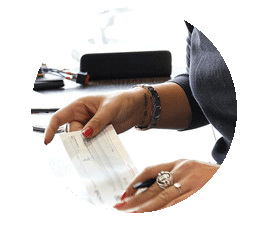Navigating the complexities of business taxes in Canada demands a strategic and informed approach. However, the steps for actually completing and As a conscientious business owner, mastering the tax preparation process is not only achievable but can be a pivotal skill in optimizing your financial landscape. In this comprehensive guide, we unveil a streamlined five-step methodology, carefully designed to empower you with the knowledge and confidence needed to navigate the intricate terrain of business taxation. Here we simplify tax preparation, guiding you from understanding your obligations to choosing the right filing method. Let's turn this complex task into a manageable and strategic process together, step by easy step.
1. Understand Your Tax Obligations
This is the first step in preparing your taxes. If the Canada Revenue Agency (CRA) considers you a Canadian resident, you must pay income tax on all you earn worldwide. This means you are still responsible for paying federal and territorial taxes in Canada, even if you work outside Canada for a part of the year.
To stay informed about your taxes, it's a good idea to sign up for the CRA's MyAccount portal, especially if you file your taxes electronically. This online portal allows you to check your current tax status anytime.
Remember, not filing your tax return when you owe taxes can have serious consequences. If you don't file, you might face penalties. These can include fines and interest charges on the amount you owe. Therefore, always stay updated about your tax status to avoid such issues.
Get the Coverage You Want at the Best Rates
Get quotes in minutes and save on the best insurance policies.
Get Quotes2. Gather Necessary Financial Documents
While various financial statements are accepted, certain forms are recommended for specific types of business activities in Canada. We've listed them below.
- Form T2125, Statement of Business or Professional Activities: Ideal for individuals reporting income from business or professional activities.
- Form T2042, Statement of Farming Activities: Designed specifically for reporting income from farming operations.
- Form T2121, Statement of Fishing Activities: This form is tailored for those reporting income from fishing activities.
- Form T1163, Statement A - AgriStability and AgriInvest Programs Information and Statement of Farming Activities for Individuals: It is used by individual farmers participating in the AgriStability and AgriInvest programs.
- Form T1164, Statement B - AgriStability and AgriInvest Programs Information and Statement of Farming Activities for Additional Farming Operations: This is an extension of Form T1163 for additional farming operations.
- Form T1273, Statement A - Harmonized AgriStability and AgriInvest Programs Information and Statement of Farming Activities for Individuals: Similar to Form T1163, but for individuals in provinces that have harmonized their AgriStability and AgriInvest programs.
- Form T1274, Statement B - Harmonized AgriStability and AgriInvest Programs Information and Statement of Farming Activities for Additional Farming Operations: The counterpart to Form T1273 for additional farming operations.
When it comes to actually preparing your taxes, you have several options. Many people in Canada use tax preparation software, which is often inexpensive and sometimes free. This software can simplify the process and even enable you to file electronically with the Canada Revenue Agency.
However, if you're unsure or need specific advice, consider consulting a tax preparer, an accountant, or a volunteer at a free tax clinic.
For those who prefer the traditional method, you can complete your tax return by hand. You can download and print the necessary forms from the CRA website or order them by phone at 1-855-330-3305. Once you've filled them out, you can mail them directly to the CRA.
3. Choose the Right Tax Preparer
Tax laws can vary greatly from one place to another. That's why it is important to work with someone knowledgeable about the specific tax regulations where your business operates.
For example, if your business activities extend to different countries, you'll need a tax preparer who understands both tax systems. This is where location becomes key.
A Canadian tax expert would be ideal if your business is primarily based in Canada. However, if you have significant business dealings in another location, say San Diego, choosing a professional tax preparer in San Diego would be wise. They will be more familiar with local tax laws and regulations, which can differ significantly from those in Canada.
This careful selection can save you from potential legal issues and help optimize your tax benefits.
4. Identify Eligible Deductions
The Canada Revenue Agency provides a comprehensive list of common business expenses you can deduct from your income.
If you use supplies indirectly in your business, like cleaning supplies for a plumbing service, these costs are deductible. Similarly, business taxes, fees, licenses, and dues are deductible, except for club membership dues primarily for dining, recreation, or sports.
Office expenses like pens, paper, and stationery are deductible. But remember that larger items like furniture are considered capital items and are not included in this category.
For those who use part of their home for business, a portion of home expenses like heat, electricity, and mortgage interest can be deducted. This deduction is based on the proportion of your home used for business.
Salaries, wages, and benefits paid to employees are deductible, as are certain travel expenses. There are limits on deductions for meals and entertainment, though.
Other deductible expenses include rent for business property, management and administration fees, interest and bank charges on business loans, property taxes, and telephone and utility costs. For a comprehensive look at small business deductions, consider Group Enroll’s publication on the topic.
5. Fill Out the Tax Forms Accurately
There are several options for filing your taxes, each with its own process and timeline. Here's a straightforward breakdown.
- Certified tax software (electronic filing): This option is suitable for Canadian residents. You can choose from free or paid CRA-approved tax software. The processing time for electronic filing is typically within two weeks.
- Authorize a representative: This involves authorizing an accountant to complete your taxes and access your tax accounts. The cost can vary depending on the accountant, and the processing time is also within two weeks.
- Community volunteer tax clinic: Ideal for individuals with modest income and simple tax situations. This service is free of charge. The processing time is generally within two weeks.
- Discounter (a tax preparer): This option is open to anyone. A discounter calculates your refund and pays you a discounted tax refund immediately before they file your tax return. The cost can vary.
- Paper tax return: Suitable for anyone comfortable with manual processes. This method involves completing and filing your taxes using a paper return. It is a free service, but the processing time is longer, approximately eight weeks if filed on time.
Related Article
Need more valuable tips on how to manage your business taxes?
Read this ArticleThe Takeaway
Navigating the intricate realm of Canadian business taxes is indeed a journey. From comprehending your obligations to selecting the right filing method, this guide simplifies each step, transforming the seemingly formidable task into a strategic and manageable process. As you embark on optimizing your financial landscape, remember that Insurdinary stands ready to assist with a comprehensive suite of insurance products tailored for smart business owners. Explore our resources for insightful business and tax-related content on our blog. Smart decisions, informed choices, and financial empowerment await.





